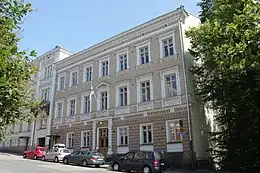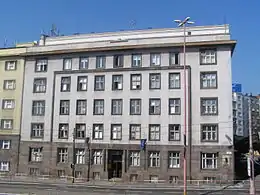Academy of sciences
An academy of sciences is a type of learned society or academy (as special scientific institution) dedicated to sciences that may or may not be state funded. Some state funded academies are tuned into national or royal (in case of the United Kingdom i.e. Royal Society of London for Improving Natural Knowledge) as a form of honor.
%252C_Frescati%252C_Norra_Djurg%C3%A5rden%252C_Stockholm.jpg.webp)





The other type of academies are Academy of Arts or combination of both (e.g., American Academy of Arts and Sciences). Academy of Letters is another related expression, encompassing literature. In non-English-speaking countries, the range of academic fields of the members of a national Academy of Science often includes scholarly disciplines which would not normally be classed as "science" in English. Many languages use a broad term for systematized learning which includes both natural sciences and social sciences and fields such as literary studies, linguistics, history, or art history. (Often these terms are calques from Latin scientia (the etymological source of English science) and, accordingly, derivatives of the verb 'know', such as German Wissenschaft, Swedish vetenskap, Hungarian tudomány, Estonian teadus or Finnish tiede.) Accordingly, for example the Austrian Academy of Sciences (Österreichische Akademie der Wissenschaften), the Hungarian Academy of Sciences (Magyar Tudományos Akadémia), or the Estonian Academy of Sciences (Eesti Teaduste Akadeemia) also cover the areas of social sciences and humanities.
As the engineering sciences have become more varied and advanced, there is a recent trend in many advanced countries to organize the National Academy of Engineering (or National Academy of Engineering Sciences), separate from the national academy of sciences.
Academies of science play an important role in science diplomacy efforts.[1] Academies are increasingly organized in regional or even international associations. The Interacademy Partnership for example is a global network consisting of over 140 national, regional and global member academies of science, engineering and medicine.[2] Additionally, there are many regional associations such as ALLEA in Europe, NASAC as the Network of African Science Academies, IANAS in Latin America, and AASSA in Asia.
Apart from national academies of science, there are now increasingly also national young academies.[3] National young academies usually select members for a limited term, normally 4–5 years, after which members become academy alumni. Young academies typically engage with issues important to young scientists. These include, for example, science education or the dialog between science and society. Most young academies are affiliated with a senior Academy of Sciences or with a network of senior academies. The Global Young Academy, which itself is a science academy (e.g. full member of Interacademy Partnership) often serves as a facilitator of the growing global network of young academies. Since its creation, more than 35 national young academies have been established. In 2019, there were 41 national young academies.
List
- Afghanistan – Academy of Sciences of Afghanistan
- Albania – Academy of Sciences of Albania
- Argentina – National Academy of Sciences of Argentina
- Armenia – National Academy of Sciences of Armenia
- Austria – Austrian Academy of Sciences
- Australia – Australian Academy of Science
- Azerbaijan – National Academy of Sciences of Azerbaijan
- Bangladesh – Bangladesh Academy of Sciences
- Belarus – National Academy of Sciences of Belarus
- Belgium – Royal Academies for Science and the Arts of Belgium
- Brazil
- Brazilian Academy of Sciences
- Pernambuoc Academy of Science
- Bulgaria – Bulgarian Academy of Sciences
- Canada
- Chile – Academia Chilena de Ciencias
- China
- Chinese Academy of Sciences
- Chinese Academy of Engineering
- Chinese Academy of Social Sciences
- Hong Kong Academy of Sciences
- Costa Rica – Academia Nacional de Ciencias (Costa Rica)
- Croatia – Croatian Academy of Sciences and Arts
- Czech Republic – Czech Academy of Sciences
- Denmark – Royal Danish Academy of Sciences and Letters
- Estonia – Estonian Academy of Sciences
- Finland
- France – French Academy of Sciences
- Georgia
- Germany
 Academy of Sciences Leopoldina in Germany
Academy of Sciences Leopoldina in Germany- German National Academy of Sciences Leopoldina
- Union of Regional German Academies of Sciences and Humanities:
- Akademie der Wissenschaften und der Literatur
- Academy of Sciences and Humanities in Hamburg
- Bavarian Academy of Sciences and Humanities
- Berlin-Brandenburg Academy of Sciences and Humanities
- Göttingen Academy of Sciences and Humanities
- Heidelberg Academy for Sciences and Humanities
- North Rhine-Westphalian Academy of Sciences, Humanities and the Arts
- Saxon Academy of Sciences and Humanities
- acatech
- Ghana – Ghana Academy of Arts and Sciences
- Greece – Academy of Athens
- Hungary – Hungarian Academy of Sciences
- India
- Indonesia
- Iran – Academy of Sciences of Iran
- Italy
- Lincean Academy
- Accademia Pontaniana
- Accademia Cosentina
- Accademia Nazionale delle Scienze (detta dei XL)
- Accademia Nazionale Virgiliana di Scienze Lettere ed Arti
- Accademia delle Scienze dell'Umbria
- Israel – Israel Academy of Sciences and Humanities
- Japan
- Kazakhstan – National Academy of Sciences of the Republic of Kazakhstan
- Kyrgyzstan – National Academy of Sciences of the Kyrgyz Republic
- Latvia – Latvian Academy of Sciences
- Lebanon – Lebanese Academy of Sciences
- Liechtenstein - Naturwissenschaftliches Forum
- Lithuania – Lithuanian Academy of Sciences
- Mexico – Mexican Academy of Sciences
- Moldova – Academy of Sciences of Moldova
- Mongolia – Mongolian Academy of Sciences
- Montenegro
- Morocco – Hassan II Academy of Sciences and Technologies
- Netherlands – Royal Netherlands Academy of Sciences
- New Zealand – Royal Society of New Zealand
- Nigeria – Nigerian Academy of Science
- North Korea – Academy of Sciences of the Democratic People's Republic of Korea[5]
- North Macedonia – Macedonian Academy of Sciences and Arts
- Norway
- Pakistan – Pakistan Academy of Sciences
- Philippines - National Academy of Science and Technology
- Poland
- Portugal – Lisbon Academy of Sciences
- Romania – Romanian Academy
- Russia – Russian Academy of Sciences
- San Marino – International Academy of Sciences San Marino
- Serbia – Serbian Academy of Sciences and Arts
- Singapore – Singapore National Academy of Science
- Slovakia – Slovak Academy of Sciences
- Slovenia – Slovenian Academy of Sciences and Arts
- South Africa - Academy of Science of South Africa
- South Korea – National Academy of Sciences, Republic of Korea
- Soviet Union – Soviet Academy of Sciences
- Spain – Spanish Royal Academy of Sciences
- Sri Lanka – National Academy of Sciences of Sri Lanka
- Sweden – Royal Swedish Academy of Sciences
- Switzerland – Swiss Academies of Arts and Sciences
- Taiwan – Academia Sinica
- Thailand
- Royal Institute of Thailand
- Thai Academy of Science and Technology
- Turkey
- Turkish Academy of Sciences
- Mesopotamian Academy /Beyt Nahrin Mesopotamian Academy of Arts and Sciences
- Ukraine – National Academy of Sciences of Ukraine
- United Kingdom
- United States
- National Academies
- American Academy of Arts and Sciences
- State-specific
- California – California Academy of Sciences
- Illinois – Illinois State Academy of Science [6]
- Mississippi – Mississippi Academy of Sciences
- Missouri – Academy of Science, St. Louis
- New York – New York Academy of Sciences
- Pennsylvania - Pennsylvania Academy of Science
- Texas – Texas Academy of Sciences
- Wisconsin – Wisconsin Academy of Sciences, Arts, & Letters [7]
- Vatican City – Pontifical Academy of Sciences
- Jordan and the Islamic world – Islamic World Academy of Sciences (IAS)
- Developing world – TWAS
- ASEAN – ASEAN Academy of Engineering and Technology
- Academy – World Academy of Art and Science
See also
References
- Hassan, Mohamed (10 March 2015). "Academies of Science as Key Instruments of Science Diplomacy". Science & Diplomacy. 4 (1).
- "About IAP". www.interacademies.org. Retrieved 2021-06-01.
- "National Young Academies". Global Young Academy. Retrieved 2019-08-24.
- Hiilamo, Elli-Alina (29 July 2019). "Pitäisikö Suomen vastata Unkarin kritiikkiin? Tutkija toivoo EU:n reagoivan 'härskiin mustamaalaukseen', ettei Suomen uskottavuus kärsisi". Helsingin Sanomat (in Finnish). Retrieved 30 July 2019.
- Hoare, James E. (2012). "Academy of Sciences". Historical Dictionary of Democratic People's Republic of Korea. Lanham: Scarecrow Press. p. 36. ISBN 978-0-8108-7987-4.
- "Illinois State Academy of Science – since 1907 | Uniting and expanding scientific interests for all in Illinois and beyond". Retrieved 2020-11-06.
- "wisconsinacademy.org". www.wisconsinacademy.org. Retrieved 2020-11-15.
